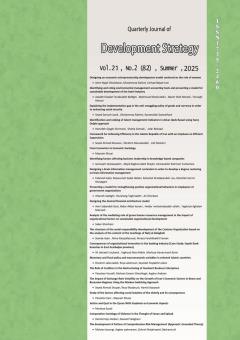The development A Pattern of Comprehensive Risk Management (Approach: Grounded Theory)
Subject Areas : اقتصادیmohsen bozorgi 1 , asghar pakmaram 2 , Zohreh Khajeh Saeid 3 , ali besharat 4
1 - Doctoral Student, Department of Financial Engineering, Maragheh Branch, Islamic Azad University, Maragheh, Iran
2 - Dept. of Accounting, Faculty of Management and Accounting, Bonab Branch, Islamic Azad University, Bonab, Iran
3 - Assistant Professor, Department of Economics, Faculty of Humanities, Maragheh Branch, Islamic Azad University, Maragheh, Iran
4 - Assistant Professor, Department of Accounting, Maragheh Branch, Islamic Azad University, Maragheh, Iran
Keywords: Comprehensive Risk Management, Capital Market, Grounded Theory,
Abstract :
Comprehensive risk management is an integrated and continuous process for managing risks in all corporate dimensions, including strategic, financial, operational, compliance and credit risks, in order to minimize unexpected performance changes and maximize the inherent value of the company. This process enables the board and management to make more informed and informed decisions about their performance risk by mapping out the fundamental needs related to corporate governance and policies, risk data and analytics, risk management and performance monitoring and reporting. to bring The purpose of this research is to provide a comprehensive risk management model in the Iranian capital market using a qualitative approach (foundation data theory). The data collection tool was a semi-structured interview with experts. For this purpose, in 2023, by using the targeted sampling approach (snowball), in-depth interviews were conducted with 24 experts who had opinions and experience in the field of risk management. The research data was analyzed using coding method and using Maxqda software. Based on the presented model, in general, the results showed that in the field of causal conditions, experts and experts believed that the most important factors affecting comprehensive risk management are categories that include capital market cycle phases, including risk management planning, identifying risks, performing analysis Qualitative risk is the implementation of quantitative risk analysis, risk response planning, risk control. Seven main categories, i.e. senior management authority, risk management unit, control, governance, risk culture model, strategies and appetite, policies and procedures, and skills promotion, formed the background conditions. Intervening conditions have five main categories of environmental conditions, bargaining power, risk model assessment, gap analysis and potential corrective measures. The categories related to strategies include value development, life cycle development, risk operational goal development, and integrated risk development. In this research, the results in six main categories include improving the position of the company, improving the stability of the company, learning potential, sustainable growth and development, feedback from the refiners, and improving decision making.
